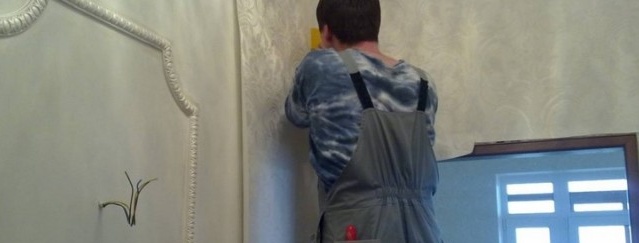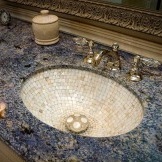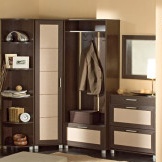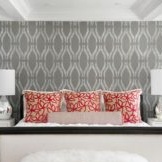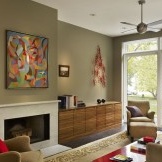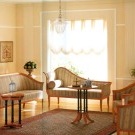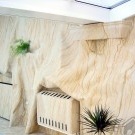How to glue wallpaper
Before you begin, we recommend that you familiarize yourself with preparation for wallpapering (marking, slicing, combining the picture and other interesting points). Today, there are many wall coverings. The most popular are wallpaperwhich, above all, perform aesthetic functions. They are used by people from ancient times, only in different countries their different types were widely used. For example, in Europe began to decorate the walls with fabric. From there came the fabric wallpaper, which is now so often used. China, Japan and other eastern countries gave rise to paper wallpaper. In part, they have some kind of reflection of these powers. The East, first of all, is famous for its habits of frequent changes in mood or environment. Like wallpaper, which implies the most frequent update. Muslims were the first to use leather wall coverings.
Choosing the right wallpaper
The process of wallpapering the walls begins with the selection of suitable ones. After all, all of them have certain characteristics that help us determine which of them are the best (in any case, for us). There are so many wallpaper manufacturers today. And they provide us with a huge selection. You can paste over them all the rooms of the house, despite the humidity or possible pollution. In order not to get confused in such a great variety, you need to understand the types and types of wallpaper.
Types of Wallpaper:
Paper. The most common wallpaper in the world. They have many advantages, but some disadvantages are manifested. First of all, people like the low cost of paper wallpaper. This allows you to change or update more often. interior rooms. Their price depends on the type of paper used, taken as a basis, and can fluctuate in a very large range, which allows them to get more people. They are considered environmentally friendly. They have high moisture and air permeability, which positively affects the walls, allowing them to breathe. Paper wallpaper "obedient" when gluing.
The following disadvantages of paper wallpaper can be distinguished - they are most susceptible to mechanical damage. These types of wall coverings are afraid of moisture and absorb odors, so it is not advisable to use them in the bathroom or kitchen. They succumb to rapid burnout or pollution, and, consequently, loss of attractiveness. They can’t be washed, basically.
To overcome some of the shortcomings of paper wallpaper, two-layer or duplex paper wallpapers were produced. They are more durable, less subject to pollution or burnout, less air and moisture. Some of them can even be washed. All this, of course, affects the price of paper wallpaper.
Vinyl. A fairly common type of coating on the walls. Its main advantage is the beautiful appearance and moisture resistance, which allows them to be washed. The basis for vinyl wallpaper is paper or non-woven. The top layer is covered with polyvinyl chloride (PVC). A variety of patterns or embossments can be applied to it. Thanks to vinyl, this wallpaper will become more durable and resistant to moisture or sunlight. They do not attract dirt and dust.
Among the shortcomings of vinyl wallpapers, their poor permeability can be distinguished. PVC film does not allow air and moisture to pass, which prevents the walls from breathing. They are not universal when pasting walls. Each type must be approached individually. Some are durable and less capricious, some require careful pasting to prevent damage to the pattern, sprinkle of gloss or coating.
Vinyl wallpapers can be divided into three types according to technological production processes. They have a different look and different properties.The top layer may be foamed, flat or hard vinyl. The first group gives an unusual look to the walls. It turns into a relief coating. These wallpapers will add uniqueness and hide a lot of bumps and flaws on the walls. They are characterized by low weight. Most of the foamed vinyl wallpapers are suitable for painting.
On a wallpaper with a flat vinyl, first, a stencil drawing is applied to the base. Then, it is covered with vinyl using embossing. Beautiful and flat wallpapers come out that imitate a lot of textures - fabric, leather, gloss, ceramic tiles and others. Their distinguishing feature is increased strength due to the thickness of the vinyl ball. Such wallpapers are often used in the kitchen or bathroom.
Wallpaper with solid vinyl appeared quite recently. They are more environmentally friendly compared to the rest. Vinyl is subjected to heat treatment, which ensures the evaporation of substances that are harmful to the human body. They are characterized by increased breathability, resistance to physical influences and mechanical damage, and the ability to not let moisture through. Apparently, they impoverished some disparate, positive features. Such wallpapers are resistant to chemical detergents. They perfectly hide minor imperfections and irregularities on the walls.
Non-woven. The type of wallpaper, by characteristics, is similar to paper. Only they have increased strength. In appearance, these wallpapers are very soft and delicate. Flizelin is a material made from natural ingredients. According to its characteristics, it is similar to fabric, but not such. Non-woven wallpaper is made from cellulose fibers with the addition of viscose and other additives to give the appearance of natural fabrics, strength and other useful properties. Walls can freely “breathe” under this material.
Non-woven wallpaper for gluing is very convenient. No swelling, blistering, or deformation occurs. A distinctive feature of their use is that they are mounted on a wall pre-coated with glue. Moreover, they themselves remain dry. They can be applied to any surface. They behave perfectly on wood, cement, slabs, plaster and other materials. It is worth noting that when applying other layers to non-woven, such as vinyl, wallpaper lose some of its properties. They can be painted (up to 3 times).
Cullet. They are based on material that is obtained by weaving from fiberglass. Most often, such wallpapers are painted. They have different ornaments and textures. One of the greatest advantages of cullet is their increased fire resistance. They are often used to decorate emergency fire escape routes. Cullets are not a medium for feeding a variety of parasites (ticks, fungus, mold, and others). They have a very long life (10-15 years, some even up to 30 years). Not afraid of water or cleaning products. They are characterized by high environmental cleanliness and safety. They are less docile when covering walls and require a lot of glue.
Textile wallpaper. They are based on paper or non-woven. The top layer is fabric (linen, silk, velor, polyester and others). They can be natural or artificial, which determines the cost of textile wallpaper and some of their characteristics. They provide the greatest degree of sound and heat insulation. Most of them cannot tolerate wet cleaning. This type of wallpaper is a very demanding material for gluing, which becomes a difficult and unpleasant process for inexperienced people.
Metallized. They, like vinyl, are based on paper or non-woven. The top layer is a foil on which drawing, pattern or embossing can be applied. People choose them because of their attractive appearance. They fill the room with a golden or silver glow. With good lighting, you can see all the beauty and advantages of metallized wallpaper. They are also very convenient to care for.They are easy to wash or wipe. Metallic wallpaper is resistant to wear and mechanical damage. They do not lose their luster over time. And the sound insulation with them is just excellent.
But also, you can highlight the disadvantages of metallized wallpaper. First of all, it is their high price. They do not pass air and moisture well, which contributes to the accumulation of condensate. To stick them you need a perfectly flat surface and special glue. All flaws will be visible, the foil will make them very noticeable.
Natural wallpaper. The basis in them is all the same paper. To which a variety of natural materials are attached using threads. It can be jute, reed, bamboo, wooden bung and many others. The first and main advantage of natural wallpapers is their environmental friendliness. In addition, they have a beautiful view. Provide excellent heat and sound insulation.
Among the shortcomings of natural wallpaper can distinguish their high cost. Their sticking is pretty complicated. Paper coated with natural materials is poorly cut and glued. This type of wallpaper absorbs smell or dust pretty well. They are highly flammable.
Liquid wallpaper. Pretty interesting option. They combine the positive properties of ordinary wallpaper and plaster. They are a combination of natural fibers of different origin and glue. They have the following positive properties - when applied to the wall, there are no seams. Hide small irregularities of the walls, they can be applied only to certain areas. Liquid wallpaper is environmentally friendly.
The disadvantages when using liquid wallpaper are the following - not resistant to moisture or mechanical damage. They need to be applied to the wall quite neatly, it is better to do this for professionals. It takes a long time to dry (up to three days).
Well, if you have decided on the choice of wallpaper for decorating your walls, then you need to proceed to pasting them. But do not rush.
The phased process of wallpapering the walls
Depending on which wallpaper will be selected for pasting on the walls and further steps will be determined. But most of the points remain the same for different types of coverage.
First, get all the tools you need. They, of course, can be borrowed, but it's still better to have your own. A rough list of the necessary tools and accessories for wallpapering the walls:
- The very first is the wallpaper and glue. We have already talked about the first. Regarding glue, we will go further.
- Spatula and water to remove old wallpaper. It is possible to use a special fluid to simplify this “not interesting” task.
- Plaster, putty, for the case when you need to level the walls.
- Sandpaper and primer. To prepare the walls before applying glue.
- Screwdriver for sockets, skirting boards and more.
- Scissors or a sharp wallpaper or stationery knife. For easier cropping of the edges of the wallpaper.
- Level, and even better a ruler and thread with a load at the end (plumb). To be able to glue the wallpaper strictly vertically.
- Brush First of all, it should have long hair and be wide. You can also get a second in reserve. It is necessary that it be compact for a more convenient application of glue on the edges of the wallpaper, in corners and other hard-to-reach spots.
- Dry and wet rags. The first is to smooth out unevenness on the wallpaper. For the same purpose, a brush with soft horsehair can be used. The second is to remove glue from the wallpaper, which turned out to be superfluous.
- Do not forget about the stepladder and good mood.
When all materials and fixtures are ready for work, it is worth starting the preparation of the walls. First you need remove old wallpaper. This can be done using a special solution, the main thing is not to forget to read the instructions for it. Or just by moistening the old wallpaper with warm water. And with a spatula or scraper to clean the wall. Possible bumps or cracks needed putty. If necessary, use sandpaper to smooth the wall. If the walls were stucco, then you need to wait a bit to allow the surface to dry.
After preparations, the surface should be primed. Very often, this process is neglected, but this should not be done. The primer is primarily made for less absorption by the walls of glue. This makes it possible to adjust the stripes of wallpaper. That is, to customize the pattern or the joints. As a primer, you can use wallpaper glue. But, in this case, it must be diluted to a more liquid state. By the way, the primer protects your walls from the possible spread of various fungi or bacteria.
While the primer is absorbed into the adhesive surface, you need to cut the wallpaper. Before this process, make sure that all rolls are from the same batch, as the tone or shade may vary even with the same color. If the wallpaper has a pattern, then it is necessary to mark with a pencil exactly where to cut it. Always leave a few centimeters of canvas free (in length). It is worth considering the degree of displacement of the wallpaper. This can be found on the back of the canvas. Where the corresponding figure is accompanied by a figure that states the offset step. But as they say, trust, but verify. Try to combine all the stripes of wallpaper on the floor. After lubricating the canvas with glue, you can begin to work. It is important not to confuse the upper and lower parts of the wallpaper.
Choose the right glue
Did you know that choosing the right glue for your wallpaper is not very simple. There are many things to consider. In addition to price and manufacturer, they have many characteristics that will affect the choice.
If someone has already come across the choice of wallpaper glue, then he knows that the range of these substances is simply great. For vinyl one box is intended, for natural - another. And no one ever wondered why there are so many of them and why not make one package for all occasions?
All this is not so simple, because each type of glue is designed for different types of wallpaper. Some wall coverings are heavier, others less. Here, for example, most types of glue are suitable for paper wallpapers. That is, they do not need to buy any special tool. As the saying goes, why not overpay. Another thing is the non-woven backing. The structure is already different. And vinyl wallpapers are too heavy for universal adhesives. So it turns out that there is cheaper material, and there are more expensive.
Another such interesting thing for inexperienced craftsmen. There is wallpaper glue with an indicator. If someone tried to lubricate the canvas, then you probably remember that it was not always visible which part had the applied adhesive and which did not. The indicator is a kind of substance that, when in contact with water, makes wallpaper glue painted. This is better seen when lubricating the strips. After some time, the coloring matter loses its color and becomes invisible.
If you walk around the specialized stores where wallpaper glue is sold, you can see the kidney with the inscription "curb." It is thicker and has a higher drying rate. After all, borders are smaller than wallpaper strips, and some of them are much heavier. Any glue comes in powder form. It is bred with water according to the recipe, which is indicated on the pack. To avoid the formation of lumps, it is advisable to pour glue into the water slowly and constantly stirring. Usually the mixture needs to settle for half an hour. After that, it should be mixed again.
Final stage
Next is the process of wallpapering the walls. It seemed that all the preparations were already behind and should not be particularly nervous. This is not entirely true. When covering the walls with wallpaper, you need to follow a few tips.
- Start pasting the surface with windows or doors. This is not particularly important, the main thing is to have a vertical reference and go in one direction. That is, if you started from some kind of aperture - finish it, but from the opposite side. So to speak, the circle closed.
- Any kind of wallpaper is always glued with closed windows and doors. In this case, the room temperature must be at least 180C. And the relative humidity of indoor air should not exceed 70%. By the way, the walls also have some limitations in this regard. For example, their moisture content should be no more than 4%. This can be achieved with a primer.
- Some wallpapers require applying glue to the canvas, the surface of the wall, or both. If air bubbles appear, they need to be smoothed out with a cloth. Only carefully to avoid damage to the wallpaper, especially paper, which when wet becomes tender. In the case when this does not help, it is worth piercing the bubble with a needle. By the way, the wallpaper needs to be smoothed from the center to the edges.
- When wallpapering, pay attention to their joints. Here you need to consider the fall of sunlight from the window. Especially when gluing adjacent lap strips.
- First, it is advisable to apply glue to the strips of wallpaper, and let them stand and soak. A little, since the canvases can simply get wet. 5 minutes is enough.
- When pasting corners, use two canvases of wallpaper with their joint overlap. Since when applying one sheet, the possibility of peeling or creasing increases.
- When using vinyl wallpaper, a situation may arise when the borders do not stick on top of them. In such situations, it is advisable to mount them directly to the wall. So longer and more laborious, but much more reliable.
- In places of outlets on the wallpaper strip, you must form a round hole. The easiest way to do this is by cutting the canvas in the shape of a cross. Then form a circle with each sector.
- And most importantly, remember that you do not need to pull with the lining of the room. Try to finish each room in a day.
Glue the corners
The outer corner is glued as follows: cut the strip of wallpaper 2.5 cm more than from the previous strip to the corner. After that, it is necessary to seal the strip, bending at the same time to the opposite angle. If the angle is right, the remainder is glued butt, otherwise the remainder is glued with an overlap along the vertical marking. Now we take a sharp knife and pass it along the corner along the ruler, cutting off the trim and pressing the edges. By the way, vinyl wallpapers are glued only butt.
Inside corner: first you need to know that a whole canvas of wallpaper should not be glued to it, because it will most likely turn out to be crooked and you will get either deviations or sketches. Now, before starting work, it is necessary to measure the distance from the corner to the last strip and add 2 cm. Now, I know the size you need, cut the strip and glue it on the corner and wall. In order for the paper in the corner to stick better, you need to hold it with a small object, for example, with the blunt end from the knife. With dense wallpaper, the remaining piece must be glued using a plumb with a lap on the adjacent part of the wall. Now we take the knife and along the ruler we go along the corner, remove the leftovers and press the edges. Thus, the joint will be imperceptible.
FAQ
- Tell me, do you need to shoot old wallpapers? Of course yes. Although it is believed that old paper wallpapers can not be removed. Well ... if you have a desire to glue the wallpaper every few years, then you can not remove it. The fact is that old wallpapers can peel off from the wall and it will be already problematic to fix this.
- Is it necessary to prime?But why? Firstly, this procedure is necessary for better adhesion of the wall surface and wallpaper. Secondly, what is a primer and why is it needed, read herehere.
- What about whitewashing, can I glue it? Of course not, the material does not stick to the surface. First, wash, clean, primer, and only then glue.
- Can I glue the paint? No, the reason is that with whitewashing - the material will not lie down, because the paint is not able to absorb glue.
If you listen to these tips, you will avoid many errors, which will then have to be fixed.

